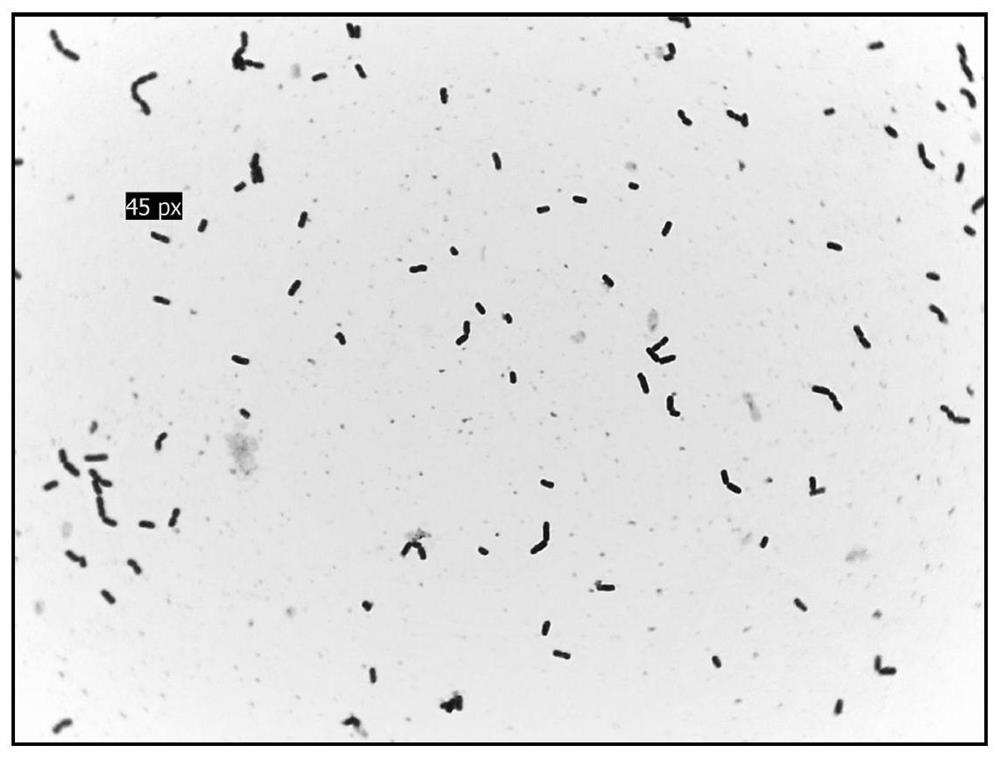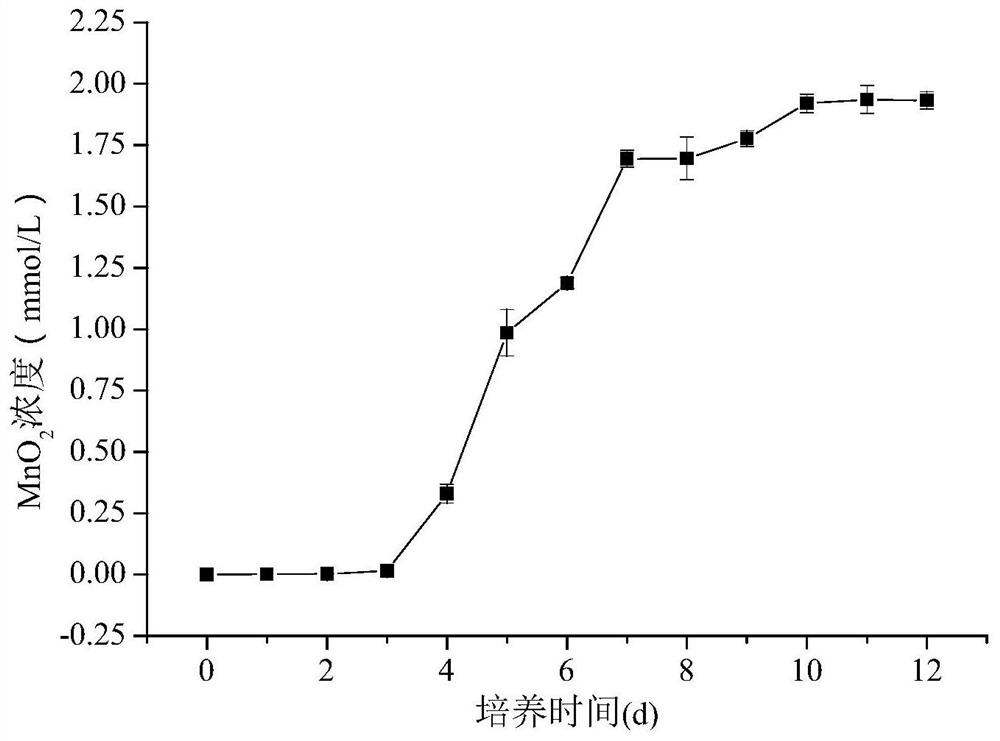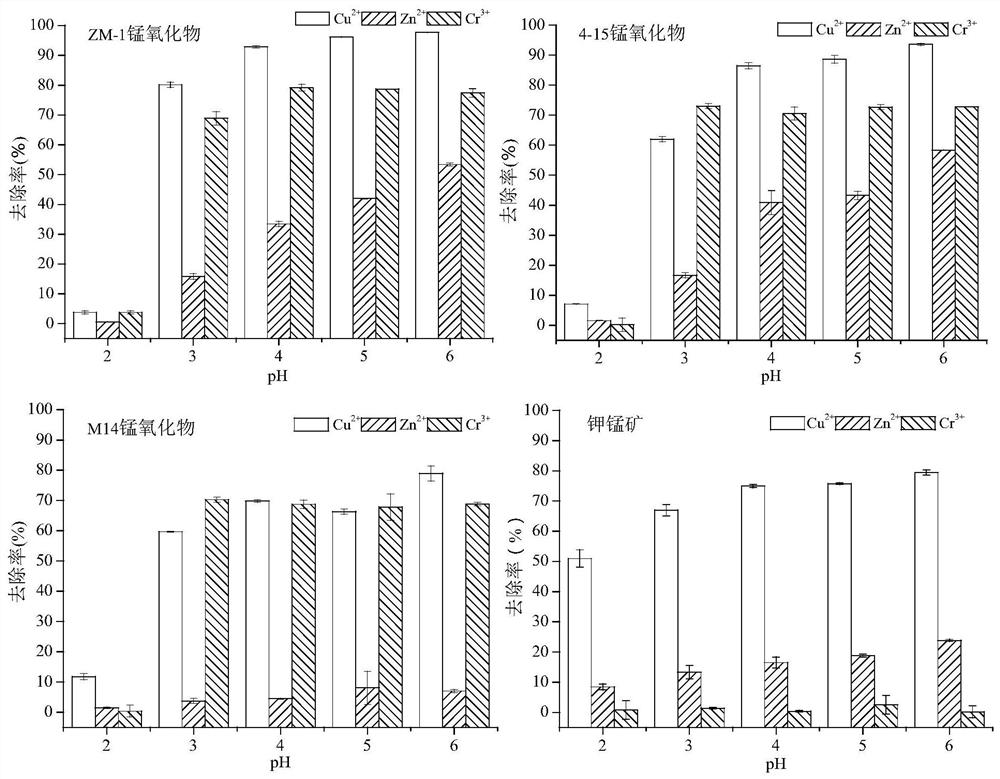A kind of manganese oxidizing bacteria and its screening method and application
A technology of manganese oxidizing bacteria and manganese oxide, which is applied in the field of environmental microorganisms to achieve the effect of low cost and high manganese oxidation ability
- Summary
- Abstract
- Description
- Claims
- Application Information
AI Technical Summary
Problems solved by technology
Method used
Image
Examples
Embodiment 1
[0022] Embodiment 1: Screening of manganese oxidizing bacteria
[0023] The screening method of manganese oxidizing bacteria of the present invention has the following steps:
[0024] (1) Preparation of manganese-containing medium: 5g of yeast extract, 10g of tryptone, 10g of sodium chloride, 1000mL of distilled water, adjust the pH to 7, distribute in 250mL triangular flasks, 100mL in each bottle, and put them in a sterilizing pot 121℃ high temperature steam sterilization for 20min, after cooling, add appropriate amount of filter-sterilized 1mol / L MnCl 2 solution and biological buffer 1mol / L HEPES (pH 7.0), so that the final concentrations of medium Mn(II) and HEPES were 1mmol / L and 20mmol / L, respectively.
[0025] (2) Preliminary screening of manganese oxidizing bacteria: respectively inoculate bacterial liquids of various strains to be screened in the logarithmic phase of growth in the manganese-containing liquid medium of the above-mentioned step S1 according to an inocul...
Embodiment 2
[0030] Embodiment 2: Identification of manganese oxidizing bacteria
[0031] A strain numbered ZM-1 obtained above was identified as Bacillus amyloliquefaciens ZM-1 through morphological identification, biochemical identification and 16S rRNA sequencing analysis;
[0032] 1. The growth physiological form of the bacteria is as follows: a bacterial film is formed in the liquid medium, and the colony on the solid medium is light yellow, opaque, rough on the surface, and irregular in edges;
[0033] 2. If figure 1 Gram identification results shown are Gram-positive bacteria, known Gram-positive bacteria are blue-purple, Gram-negative bacteria are red, figure 1 After Gram staining, it becomes blue-purple, so it is Gram-positive bacteria;
[0034] 3. The results of biochemical identification are aerobic, short rod-shaped (0.7-3.0um), motile, and round spores; positive for nitrate reduction, positive for catalase, positive for hydrolyzed starch, liquefied gelatin, and indole test ...
Embodiment 3
[0039] Implementation 3: Determination of Manganese Oxidation Ability of Manganese Oxidizing Bacteria ZM-1
[0040] (1) Prepare manganese-containing liquid culture medium and distribute them in 250mL Erlenmeyer flasks, 100mL per bottle. Under aseptic operation, add MnCl sterilized by 0.22 μm microporous filtration 2 Solution and HEPES (pH 7.0), make the final concentration of HEPES be 20mmol / L, the final concentration of Mn(II) be 6mmol / L, inoculate the ZM-1 bacterium liquid of growth logarithmic phase by 2% inoculum size.
[0041] (2) Each Erlenmeyer flask was placed in a constant temperature shaker at 30° C. and 180 rpm for shaking culture. Three parallel samples were taken in each group to measure the manganese oxide concentration every 24h until the end of 12d sampling.
[0042] (3) if figure 2 As shown, the manganese oxidation by manganese oxidizing bacteria ZM-1 increased rapidly from 0.01mmol / L at 3d to a maximum of 1.92mmol / L at 10d at 3-10d. The maximum manganese...
PUM
 Login to View More
Login to View More Abstract
Description
Claims
Application Information
 Login to View More
Login to View More - R&D
- Intellectual Property
- Life Sciences
- Materials
- Tech Scout
- Unparalleled Data Quality
- Higher Quality Content
- 60% Fewer Hallucinations
Browse by: Latest US Patents, China's latest patents, Technical Efficacy Thesaurus, Application Domain, Technology Topic, Popular Technical Reports.
© 2025 PatSnap. All rights reserved.Legal|Privacy policy|Modern Slavery Act Transparency Statement|Sitemap|About US| Contact US: help@patsnap.com



